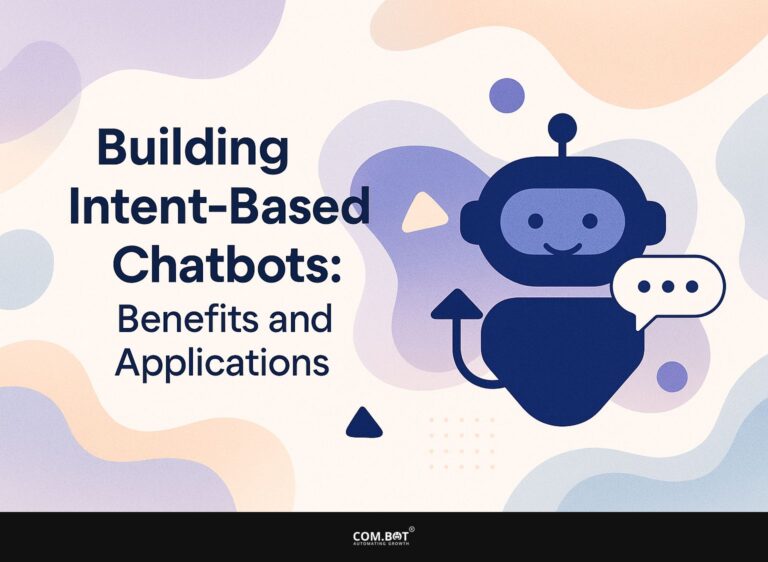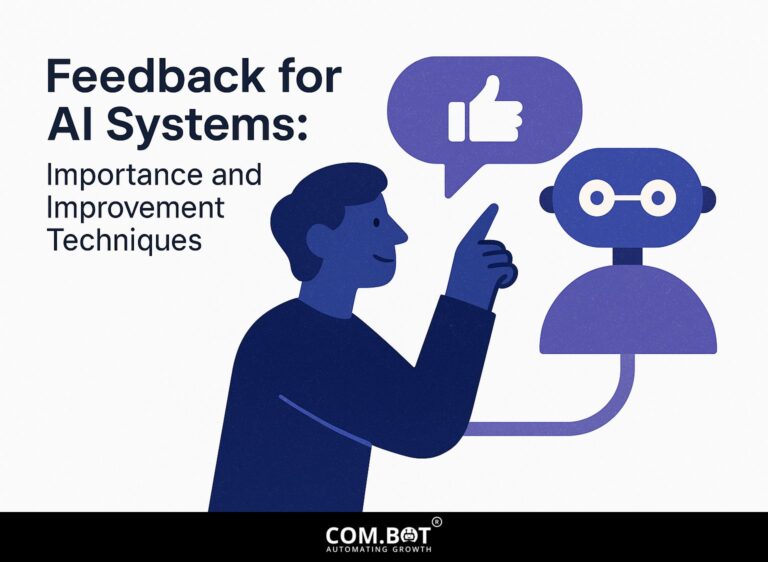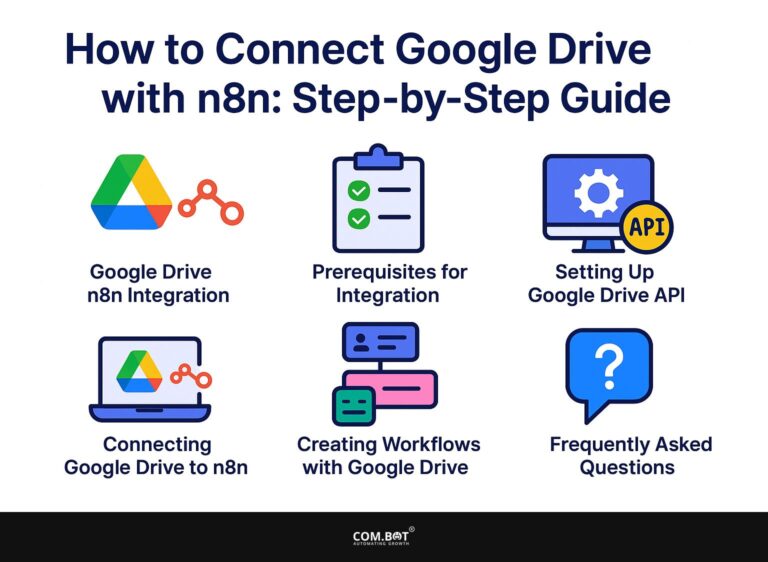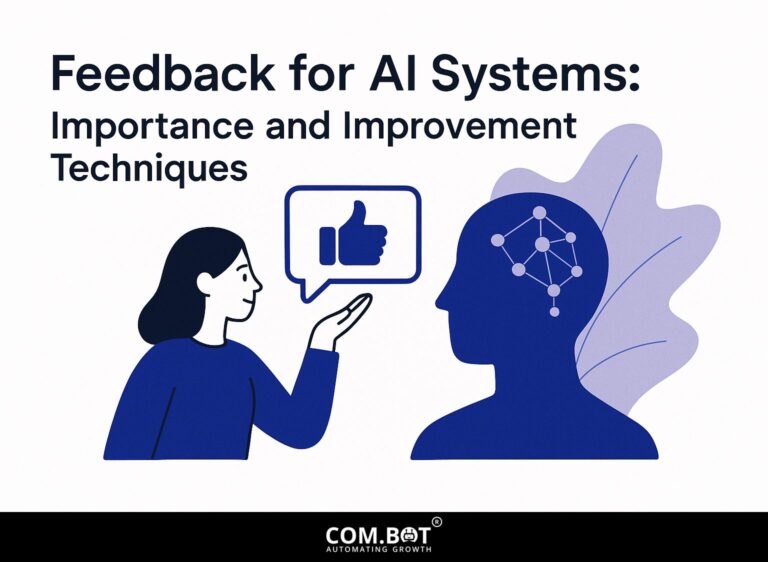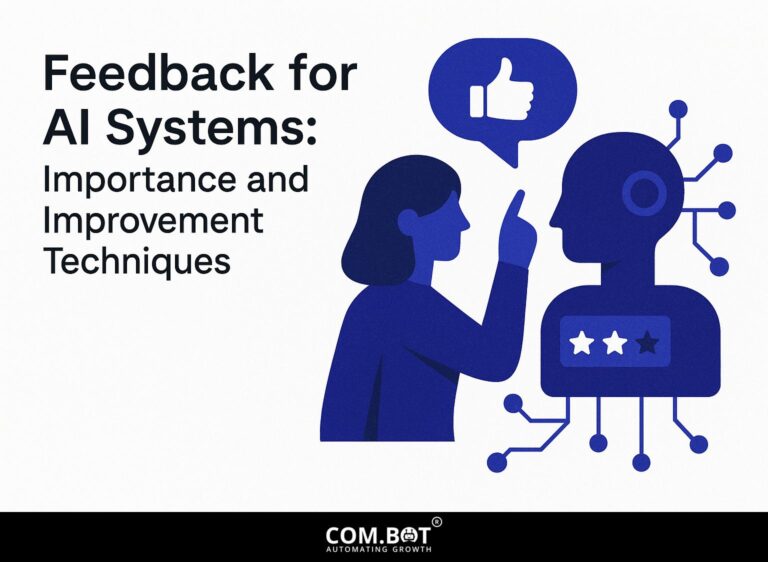Feedback for AI Systems: Importance and Improvement Techniques
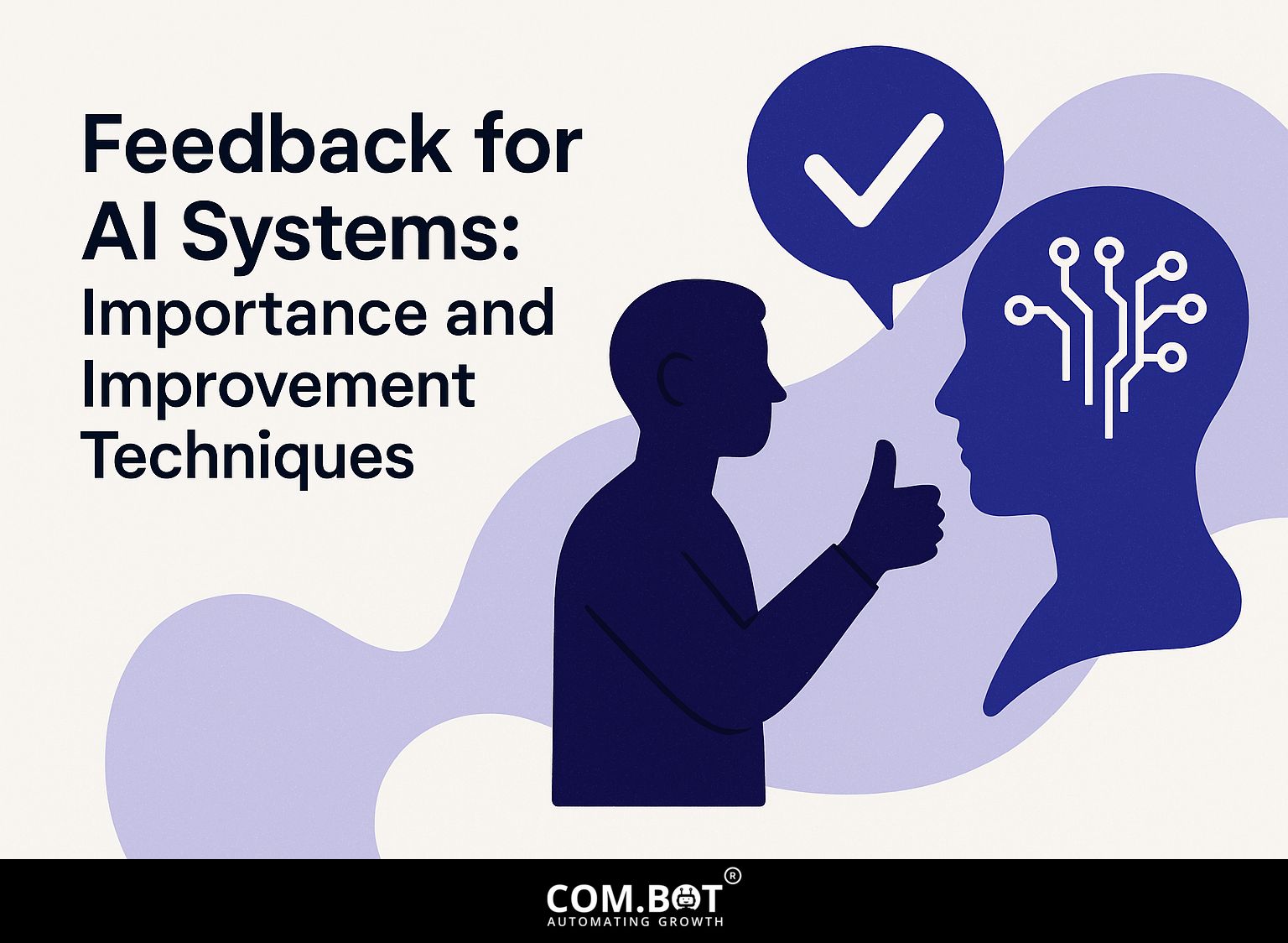
In the fast-changing field of Artificial Intelligence, creating a strong AI feedback loop is key to improving performance. By using guided feedback and ongoing learning, AI systems can change and succeed in complicated settings. This article looks at how feedback is important in AI, focusing on ways to improve machine learning results and gain user trust. Learn how giving useful feedback can change your AI projects and encourage new ideas.
Key Takeaways:
- 1 Importance of Feedback
- 2 AI Feedback System Statistics
- 3 Types of Feedback
- 4 Techniques for Collecting Feedback
- 5 Implementing Feedback into AI Systems
- 6 Challenges in Feedback Implementation
- 7 Future Directions
- 8 Frequently Asked Questions
- 8.1 What is the importance of feedback for AI systems?
- 8.2 How does feedback help in improving AI systems?
- 8.3 What are some techniques for providing effective feedback to AI systems?
- 8.4 Can feedback help avoid biased choices in AI systems?
- 8.5 How can feedback be included in the development process of AI systems?
- 8.6 Is feedback necessary for all types of AI systems?
Definition of Feedback in AI
In AI, feedback is the process of using results to improve algorithms, which helps increase their effectiveness over time.
Feedback mechanisms can be broadly categorized into supervised and unsupervised learning.
In supervised learning, algorithms learn from labeled data; for instance, when a model predicts house prices based on historical data, adjustments are made based on the accuracy of predictions.
Conversely, unsupervised learning entails algorithms drawing inferences from data without labels, such as clustering user behaviors to identify patterns.
These feedback loops help systems get better over time, which increases accuracy and improves decision-making.
Overview of AI Systems
AI systems include various technologies such as machine learning algorithms and automated systems. They rely on data examination to make decisions.
These systems use large amounts of data to teach algorithms how to identify patterns and predict outcomes.
A machine learning model for predicting sales can look at past sales data to guess upcoming trends, helping businesses adjust their plans based on these predictions. Tools like TensorFlow or PyTorch can facilitate the development of such models.
Applying predictive analytics in customer management tools like Salesforce helps make better choices and achieve improved outcomes. If you’re interested in exploring further, you might appreciate our insights on AI Bots for Customer Support: Benefits and Satisfaction.
Importance of Feedback
Feedback is important for making AI better, helping systems learn from errors and build trust and openness with users.
AI Feedback System Statistics
AI Feedback System Statistics
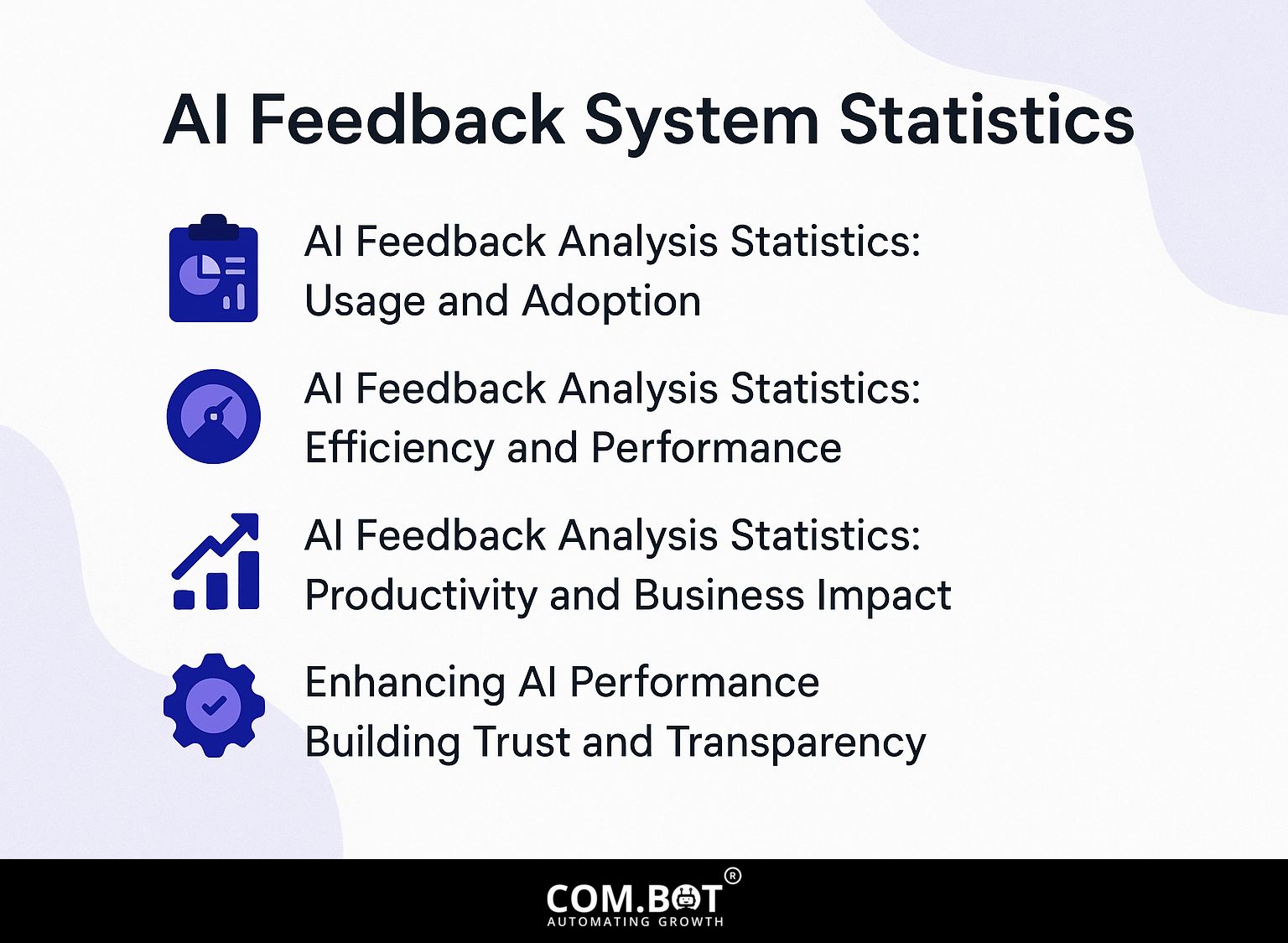
AI Feedback Analysis Statistics: Usage and Adoption
AI Feedback Analysis Statistics: Efficiency and Performance
AI Feedback Analysis Statistics: Productivity and Business Impact
The AI Feedback System Statistics The report explains how AI tools are changing user experience (UX) research and business operations. These statistics show that more people are using AI feedback systems, which are becoming more effective and improving productivity.
Usage and Adoption metrics reveal that 51% of UX researchers are already utilizing AI feedback tools, with a significant 91% open to expanding their use. This shows a clear preference for using AI to improve user experience research. Additionally, the high 98% subscription retention rate of BuildBetter.ai demonstrates user satisfaction and the perceived value of these tools.
Efficiency and Performance metrics showcase substantial improvements in workflow and accuracy. The use of AI for theme detection reduces review time by 80%, allowing data to be analyzed more quickly and conclusions to be drawn. Moreover, the high 90% accuracy in multi-language processing Highlights how AI can handle different language data quickly and effectively. Automation has reduced the amount of work needed for daily operations by 40%, streamlining processes and reducing manual workload.
Productivity and Business Impact metrics indicate significant gains. AI tools like BuildBetter.ai have increased productivity by 43%, allowing teams to achieve more in less time. The reduction of 26 meetings per month due to AI tools showing how they help make communication and choices better. Financially, the average savings per person annually using BuildBetter.ai amount to $21,000, highlighting substantial cost-efficiency and ROI.
These statistics show how AI feedback systems have changed UX research and business processes, providing strong reasons for their broad use and ongoing development.
Enhancing AI Performance
Regular feedback can make AI work better by up to 30%, as shown in chatbot conversations that change based on user responses.
Chatbots such as Drift and Intercom use user ratings and feedback to improve their conversation models. By examining dialogues, these chatbots identify common problems and adjust to respond more accurately.
Metrics show that such revisions can reduce user inquiries by 20% over a few months. Setting up a way for users to rate prompts after using them aids in continuous improvement.
This method improves answers and increases user involvement by demonstrating appreciation for their feedback.
Building Trust and Transparency
Feedback helps build trust in AI systems. It helps users see how decisions are made, creating transparency.
Implementing feedback effectively requires various ethical considerations. Start with clear communication; users should know how their feedback influences AI outcomes.
For example, think about using feedback systems that let users see how their ideas improve AI replies. Make user inputs anonymous to protect data privacy and avoid bias.
Tools like Google Cloud’s AI Platform can help manage and analyze feedback while adhering to ethical standards. Creating trust by being open increases user involvement, turning feedback into a teamwork effort that helps AI developers and users.
Types of Feedback
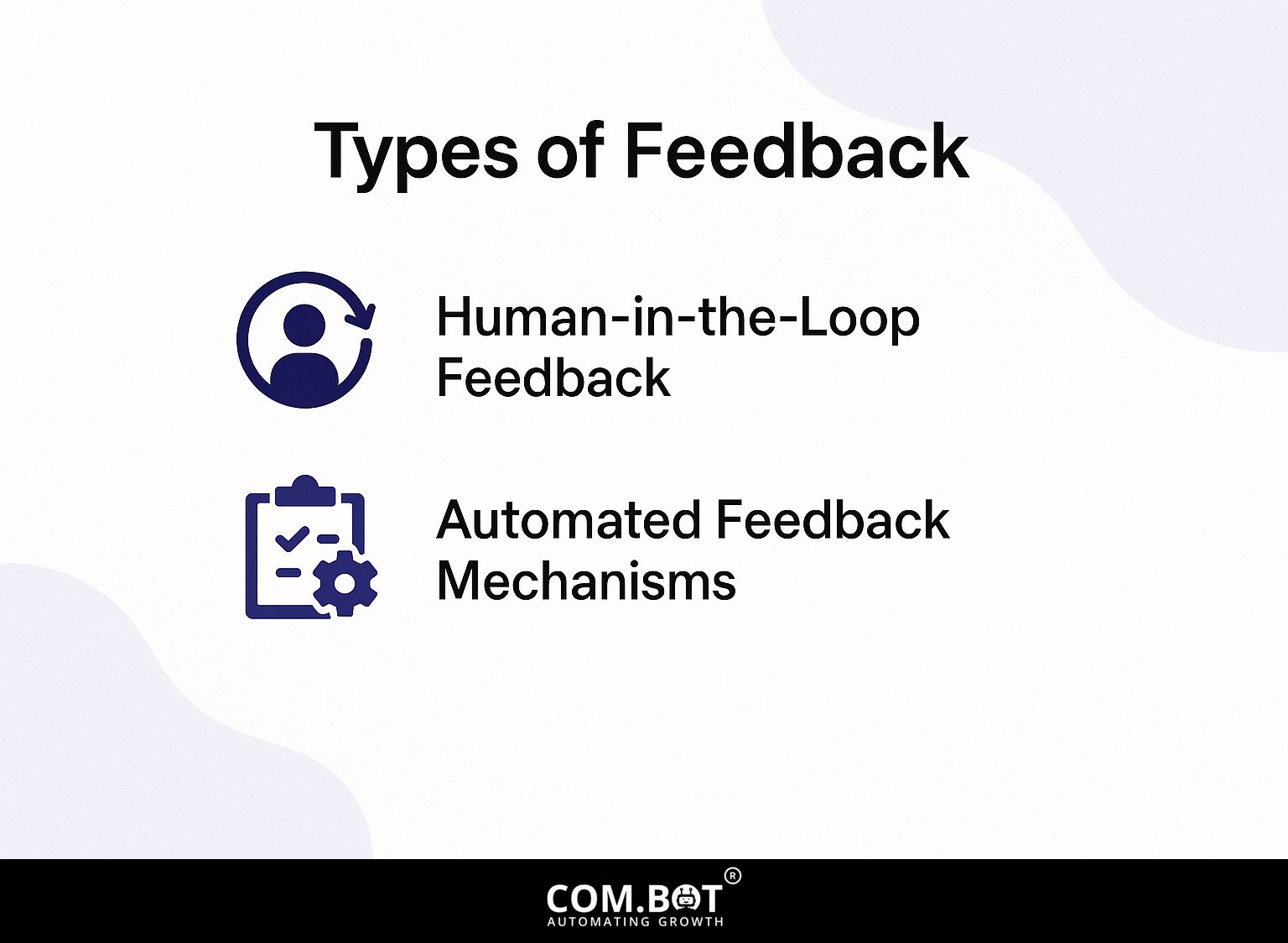
AI feedback can be divided into different groups, each offering ways to improve machine learning models and make user interactions better. This approach aligns with the principles outlined in our analysis of Feedback for AI Systems: Importance and Improvement Techniques.
Human-in-the-Loop Feedback
Human-in-the-loop feedback means users work directly with AI to improve its learning, leading to more accurate and relevant results.
This method improves AI systems by integrating human skills at important times.
For instance, in image recognition tasks, human reviewers can flag inaccuracies in identified objects, leading to a 30% improvement in accuracy after retraining.
In natural language processing, user feedback on the generated responses can help improve how well they fit the context and style, making the results more relatable.
Tools like Amazon Mechanical Turk can facilitate such feedback loops by sourcing diverse human opinions, ensuring that AI models better reflect real-world applications and user expectations.
Automated Feedback Mechanisms
Systems for automatic feedback use computer programs to look at performance data and provide feedback instantly without needing human supervision.
Industries such as e-commerce, healthcare, and online education find automated feedback very helpful.
E-commerce platforms use these systems to monitor how customers interact by changing suggestions based on user actions, which helps improve sales plans.
In healthcare, patient monitoring systems use automatic feedback to notify providers about important changes in patient information, helping them make better decisions.
Online education platforms assess student progress and develop individual learning plans on their own, which helps maintain student engagement and satisfaction.
By using tools like Google Analytics or custom AI solutions, businesses can use real-time data to make their operations better.
Techniques for Collecting Feedback
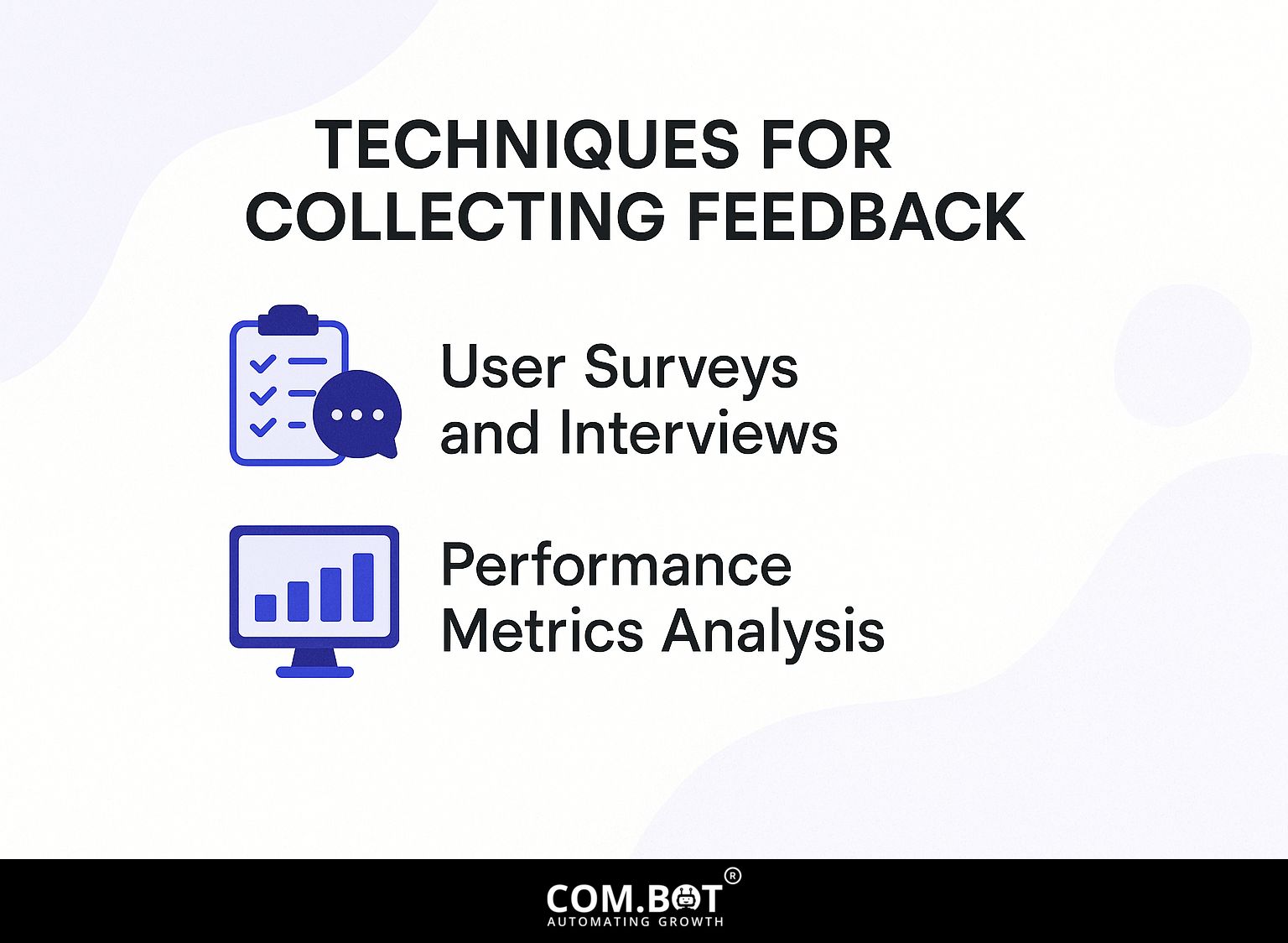
Collecting feedback accurately is key to assessing AI performance and user satisfaction, enabling targeted improvements.
User Surveys and Interviews
Surveys and interviews with users can provide important details, showing what people think and feel about AI systems.
To carry out user surveys successfully, begin by setting specific goals. For instance, if exploring user frustration with an AI tool, frame questions around specific functionalities.
Use platforms like SurveyMonkey for online surveys, which offer templates that can save time. During interviews, ask questions that require detailed answers to get more information. For example, have users talk about a recent experience with the AI system.
Recording sessions (with permission) can also help in going over detailed feedback. A practical example is OpenAI making models better by talking to users to get their feedback, which greatly raises user satisfaction.
Performance Metrics Analysis
Reviewing performance metrics gives a clear measure of how well AI is working and shows where operations can be made better.
To perform a detailed analysis, begin by using tools like Google Analytics to track website visits, as it helps you assess how users interact with your site.
Next, use Tableau to display performance data with dashboards, making it easier to see trends.
Regularly examine key metrics, such as conversion rates and user retention, to pinpoint areas for improvement.
Scheduling a review every two weeks helps you make fast adjustments to improve your AI strategy and its effectiveness.
Implementing Feedback into AI Systems
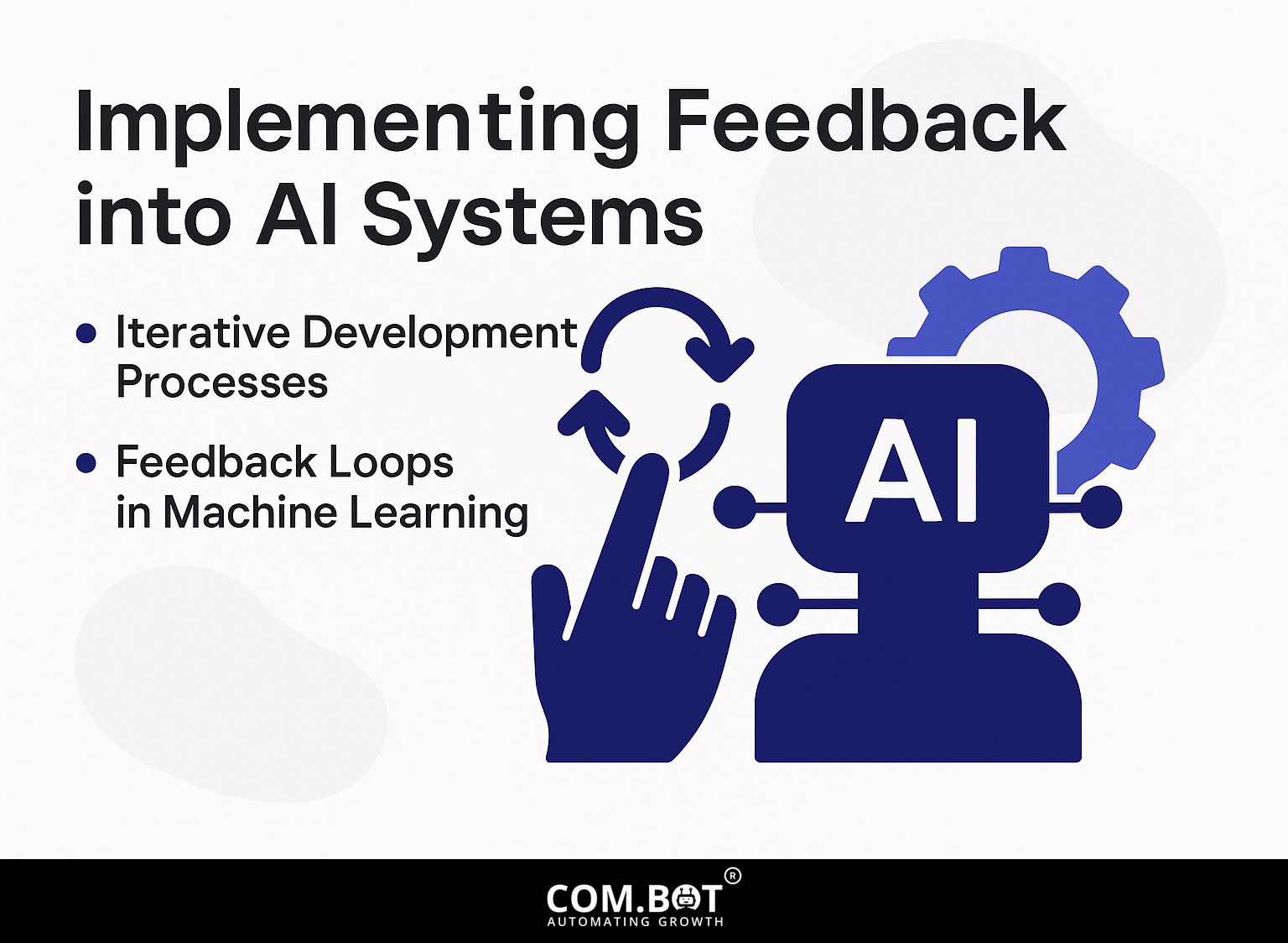
Adding feedback to AI systems means creating them in stages, so they can keep learning and changing their algorithms.
Iterative Development Processes
Using repeated development steps can improve AI systems’ ability to adjust, allowing them to handle user input and different situations well.
Using agile methods is important for ongoing development because it focuses on short work periods, known as sprints, which let teams provide regular updates.
For instance, using Scrum, teams can plan, execute, and review their work in two-week sprints, incorporating user feedback at each cycle’s end. This system promotes ongoing progress by quickly finding and fixing problems.
Tools like Jira or Trello facilitate tracking tasks and progress, ensuring transparency and collaboration among team members. By focusing on planning that can change and listening to users, organizations can improve their AI systems more effectively.
Feedback Loops in Machine Learning
Feedback loops are essential for reinforcement learning. AI systems get better by analyzing past actions and applying data to make smarter choices.
For instance, consider a recommendation system used by Netflix. It analyzes user interactions with content-like what shows are watched and rated-feeding this data back into its algorithms. This feedback helps improve future suggestions to better align with personal likes.
In a case study, using a feedback loop increased user engagement by 20%. Developers can use tools like TensorFlow and PyTorch to create systems that use past data to improve how agents learn and make decisions.
Challenges in Feedback Implementation
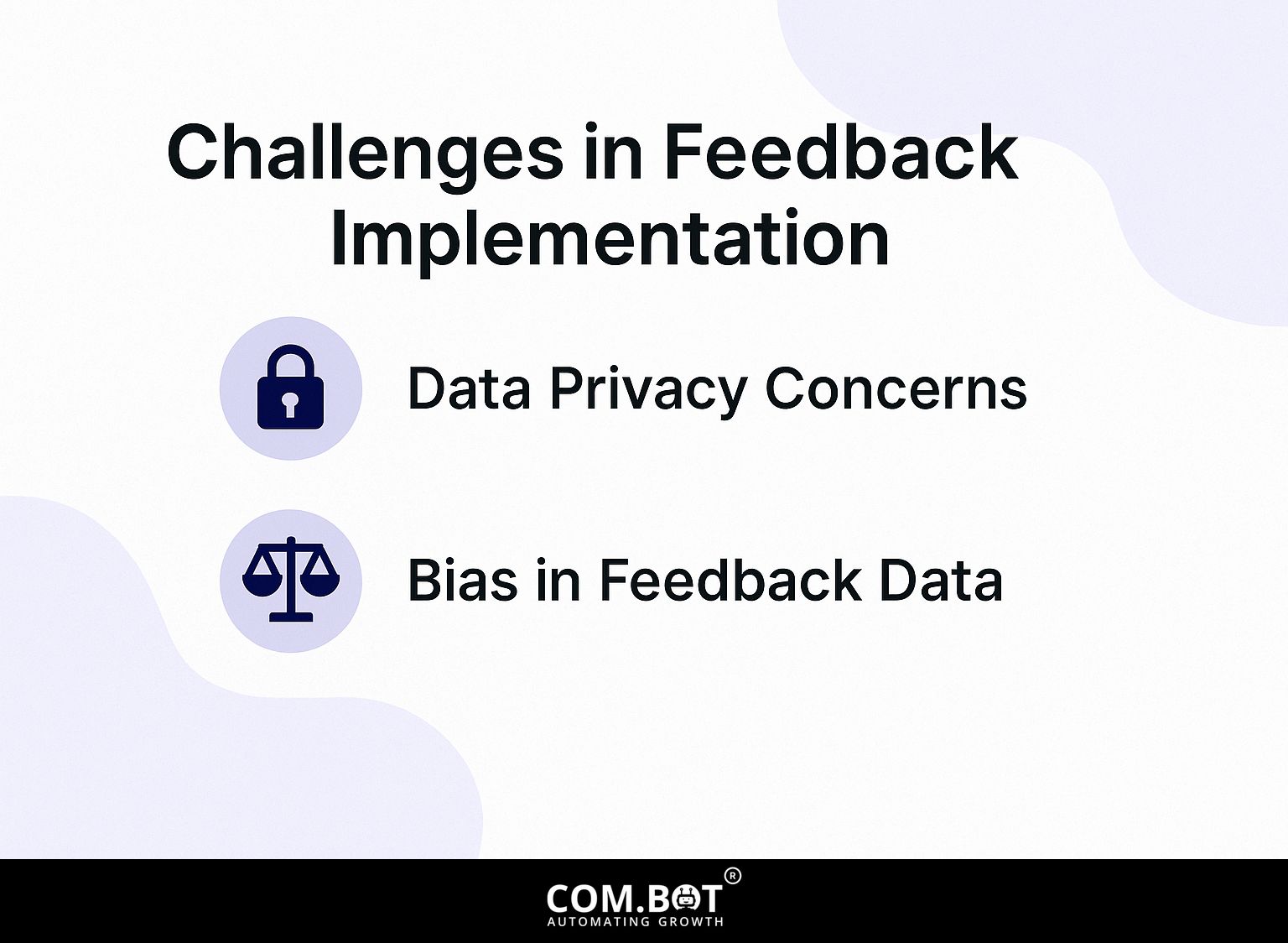
Although it can be helpful, using feedback in AI systems is not easy. Organizations need to work through different issues to make sure results are ethical and work well. For an extensive analysis of this trend, our comprehensive study on feedback improvement techniques examines the strategies that enhance AI system performance.
Data Privacy Concerns
Keeping private information secure is very important. Companies have to handle user interactions and feedback in a secure and ethical way.
To tackle these problems, organizations should use various approaches.
- Implement anonymization techniques to remove personally identifiable information from feedback data. This can be achieved using tools like DataMasker or by employing built-in capabilities in platforms like Google Analytics.
- Follow laws like GDPR by getting clear permission before gathering feedback. Including clear opt-in options in surveys builds trust and meets legal requirements.
- Regularly check your data collection methods to find and fix any weaknesses.
Bias in Feedback Data
Feedback data can contain bias, which may affect AI performance. It’s important to monitor and adjust algorithms to maintain fairness and accuracy.
To address bias, begin by identifying potential sources such as demographic data imbalances or selective sampling that may skew results.
Use methods such as ensuring datasets are balanced and diverse, or reviewing algorithms to evaluate fairness. Tools like AI Fairness 360 and Fairness Indicators help check for model bias.
Regularly updating algorithms based on real-world feedback is essential, with periodic testing to gauge improvements or new biases arising. By actively handling these factors, developers can reduce bias and improve reliability in AI systems.
Future Directions
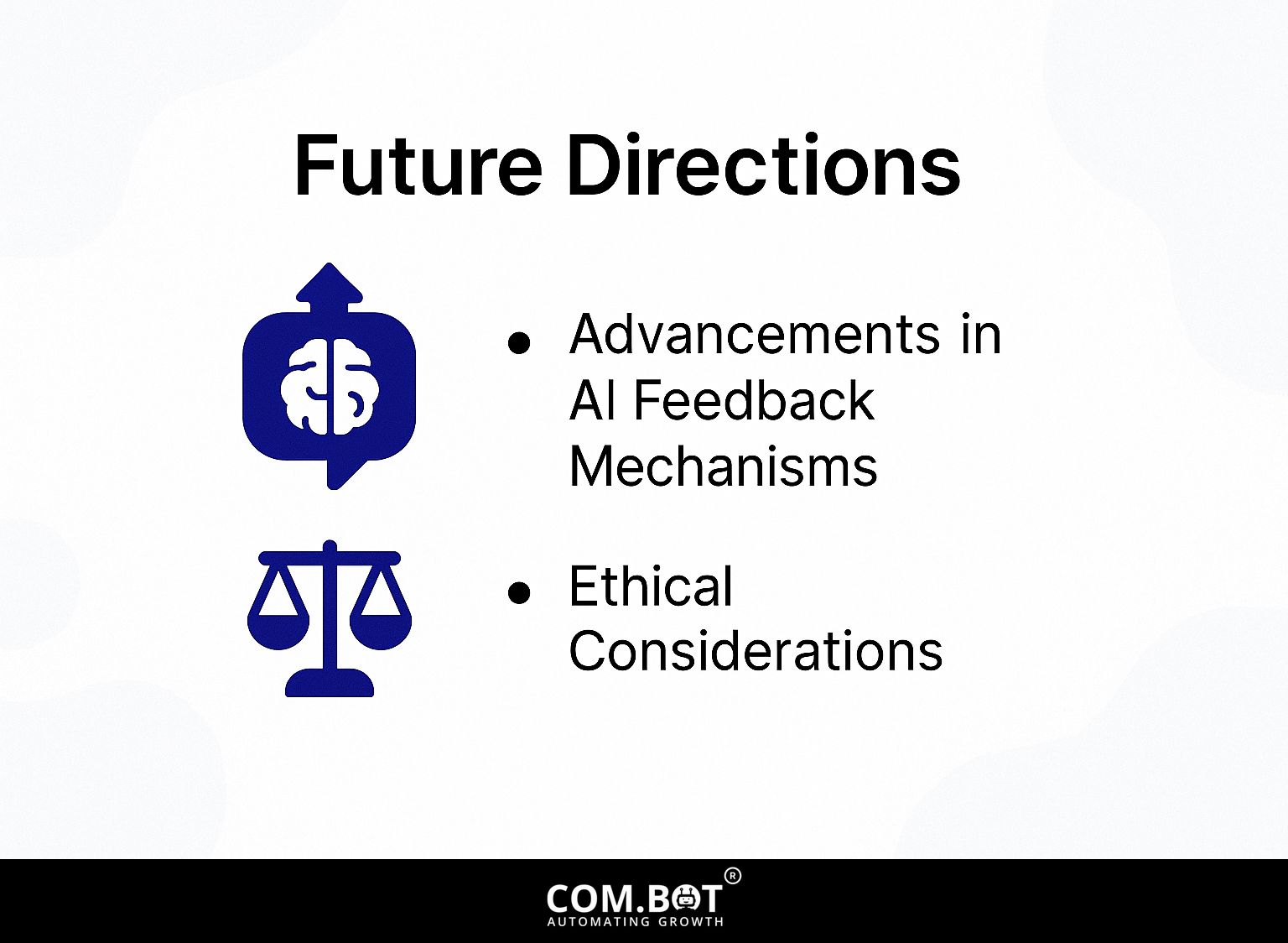
AI feedback systems are set to improve, which will greatly improve how machines and humans communicate.
Advancements in AI Feedback Mechanisms
New developments in AI feedback methods, like real-time learning and changing algorithms, are ready to change how AI systems respond to user interactions.
For instance, tools like Google’s AutoML enable developers to create custom machine learning models that improve with ongoing usage. Similarly, OpenAI’s Codex uses user feedback to improve its coding suggestions.
Meta’s PyTorch system creates computation graphs that adjust according to the data being processed. These changes allow AI systems to learn from what users do, resulting in interactions that are more suited to individual needs and work better.
Investing in these technologies can greatly improve how well your AI solutions work and how easily they can adjust. Curious about how AI feedback systems can be further enhanced? Our analysis explains the key improvement techniques.
Ethical Considerations
Ethical concerns are important in AI feedback processes, making sure that the training data is good and respects user privacy.
To improve data quality, organizations should set up clear rules for collecting feedback that focus on getting user permission and keeping information private.
For example, using clear methods like asking users through surveys can help collect information while keeping their confidence. Tools like Google Forms or Typeform make the process simpler.
It’s important to regularly check feedback systems to make sure they meet ethical standards and make changes based on user feedback. This continuous assessment encourages responsibility and progress.
Frequently Asked Questions
What is the importance of feedback for AI systems?
Feedback is essential for AI systems because it helps them learn and get better at what they do. Without feedback, AI systems wouldn’t be able to adjust to different situations or make reliable predictions.
How does feedback help in improving AI systems?
Feedback gives AI systems important details about how they are doing and any mistakes they make. This helps them find and fix their errors, which makes their decisions more accurate and quick.
What are some techniques for providing effective feedback to AI systems?
Some techniques for giving useful feedback include offering clear and specific information, using different types of feedback (positive, negative, and neutral), and having people review it to make sure it is correct and helpful.
Can feedback help avoid biased choices in AI systems?
Yes, feedback can be used to identify and address biases in AI systems. By analyzing feedback data, developers can detect patterns of bias and adjust the system’s algorithms accordingly.
How can feedback be included in the development process of AI systems?
Feedback should be included at every stage of creating AI systems, starting from gathering data and training, to testing and launching. This keeps the system learning and getting better using immediate feedback.
Is feedback necessary for all types of AI systems?
Yes, feedback is important for all types of AI systems, including machine learning algorithms, chatbots, and virtual assistants. It allows them to continuously improve and provide the best possible performance.
